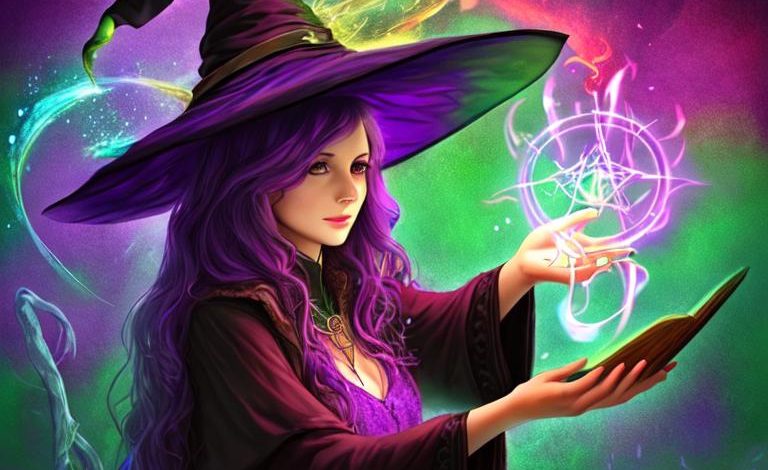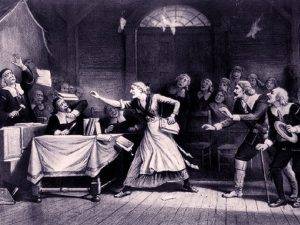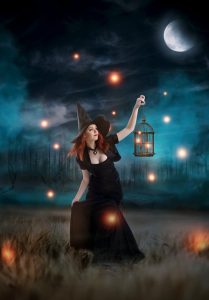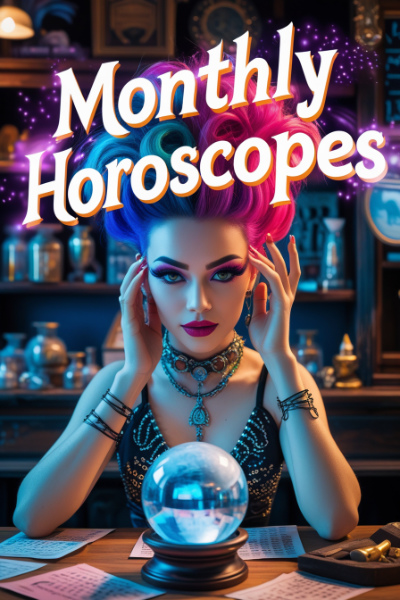
From the early Mesopotamian civilisation witchcraft was considered a serious crime, punishable by death if someone was caught practicing it. The act of witchcraft was defined as placing a curse upon a neighbour, foretelling the future and invoking spiritual powers to accomplish a supernatural task. People were defined in two ways, those who followed Christ’s teachings, or those who associated with the forces of darkness and called upon satanic powers to harm others and predict the future, the latter were called witches. It was said that a witch was someone who communes with the Devil and enters into a voluntary personal relationship with Satan, in order to be given supernatural abilities to work evil.
While it was true that some individuals did practice malicious witchcraft by invoking Satan to cause harm, most were healers and herbalists with a want to do good. Unfortunately when tragic events did occur someone was accused of witchcraft, hence many innocent women were wrongly accused, tortured and killed. It is thought that the numbers of accused and condemned witches in Europe, possibly numbered in the millions, recent studies have revealed that throughout Germany over one hundred thousand executions took place between 1500 and 1700. In Britain there was two hundred years of anti-witchcraft sentiment, as the choice of God versus Satan was debated. Through to the latter part of the seventeenth century Europeans believed in witchcraft, and many were punished for their beliefs. In the seventeenth century witch-finders were employed to seek out witches leading to approximately 30,000 so called witches, being executed between 1600 and 1640, in England.
events did occur someone was accused of witchcraft, hence many innocent women were wrongly accused, tortured and killed. It is thought that the numbers of accused and condemned witches in Europe, possibly numbered in the millions, recent studies have revealed that throughout Germany over one hundred thousand executions took place between 1500 and 1700. In Britain there was two hundred years of anti-witchcraft sentiment, as the choice of God versus Satan was debated. Through to the latter part of the seventeenth century Europeans believed in witchcraft, and many were punished for their beliefs. In the seventeenth century witch-finders were employed to seek out witches leading to approximately 30,000 so called witches, being executed between 1600 and 1640, in England.
In England there were those who were especially sensitive to the workings of Satan, they said they had been bewitched and recovered, making them adepts in the identification of witches. These amateur witch-finders went from parish to parish helping officials to cleanse the community, the more dangerous witch-finders were paid for their services, some witch-finders were paid a fee for every witch they discovered. In Plymouth in 1636 witchcraft and communicating with the Devil was an offense punishable by death, in Massachusetts in 1641 it was stated that if any woman was a witch, or consulted with a familiar spirit, she would be put to death.
The first woman to be hanged for witchcraft in New England was Alice Young in 1647, the following year in Boston midwife Margaret Jones was the first person to be hanged for witchcraft. By 1640 forty thousand English colonists had relocated to Massachusetts, an inland farming community was established named Salem Village, a church was soon established. Reverend Parris eventually took over the parsonage, he brought with him his wife Elizabeth, his eleven year old niece Abigail and his nine year old daughter Elizabeth, and a slave couple John and Tituba. In the winter of 1691 Tituba entertained Elizabeth and Abigail with tales of folk magic, a few other young women from Salem Village eventually joined them for these secret afternoon gatherings along with some women. They would come to be known as the afflicted girls, and they would accuse and cry out against two hundred individuals and charge them with practicing witchcraft.
The exact activites that took place in the Parris’s parsonage were not revealed, it was said that a spell was cast to foretell the identity of some of the girl’s future husbands. This was done by suspending egg white in a clear glass of water and seeing the face of the future husband, one girl claimed she saw a coffin instead. The fortune telling gatherings ended, but this led to some of the girls having nightmares and convulsive fits, it was believed that any divination revealing information came from Satanic supernatural powers. The girls were aware that what they had done was wrong so expected evil repercussions, the seizures of the girls became widely known. The young Elizabeth Parris began to stare blankly into space as if hypnotised, she would remain like this for hours and crawl on the floor and bark like a dog, soon Abigail began to follow the same behaviour.
This behaviour went on for months eventually the local physician was called, he declared there was nothing physically wrong, he diagnosed that the behaviour was the result of spellcasting and the girls were affected by an evil spell. The family looked to God to heal the girls, nothing improved and the girls condition worsened, the ministers called upon to help the girls deduced that they were bewitched and the evil doer must be found. The girls were questioned as to who was responsible for their affliction, young Elizabeth Parris, who was called Betty, repeated Tituba’s name after it was mentioned, once this happened Tituba was identified as the tormentor. When Abigail Williams, Betty’s cousin was questioned, and the names Sarah Good and Sarah Osborne were mentioned, Betty responded and these two were also accused of witchcraft. Tituba, Sarah Good and Sarah Osborne were the first three to be accused by the afflicted girls, two Salem magistrates issued warrants for the arrest of the three women.
The interrogation of the three women began on February 29, 1692, this took place in a tavern in Salem Village, because of the large crowd of spectators the session was adjourned to the Salem Village meetinghouse. During pretrial hearings Sarah Good was the first person to be formally examined, she was the wife of an agricultural laborer. Sarah Good often accompanied her husband to farms where he was working, many of his employers cited accidents and misfortune, Sarah Good was blamed for these, she was accused of bewitching cattle causing their death and causing injury to individuals. When she was put on the stand she was asked by the magistrate if she was in league with an evil spirit, and if she would identify the evil spirit. Sarah denied all charges, she was then asked why she muttered to herself in public places, she said that she was reciting the Psalms from the Bible, she said that she served God, when asked which God, she replied God who made heaven and earth. For his own reasons, her husband testified that she was an enemy to all good, and he believed she was a witch. When Sarah Good was asked who the tormentor of the afflicted was, she said it was Sarah Osborne. Sarah Good, who was pregnant, Sarah Osborne and Tituba were jailed based on the evidence, Tituba was the only one who escaped with her life, Sarah Osborne died in prison, Sarah Good was hanged.
The reason Tituba was freed is because she actually confessed to witchcraft and said that she was asked by the Devil to serve him. She gave an elaborate account of her activities in the realm of  black magic, concluding with her accusation of Sarah Good and Sarah Osborne of torturing afflicted children. Tituba said that she met with the Devil on several occasions, and each time she refused to obey him she was beaten by a coven of witches. She ended her statement by telling the magistrate that, even though she was being tempted by gifts and being threatened with torture, she had refused to co-operate any further with Satan. Because of her confession Tituba had turned state’s evidence, she described meetings in Salem Village coven and flying from the coven, she described familiars which she said were assigned to each of the accused witches.
black magic, concluding with her accusation of Sarah Good and Sarah Osborne of torturing afflicted children. Tituba said that she met with the Devil on several occasions, and each time she refused to obey him she was beaten by a coven of witches. She ended her statement by telling the magistrate that, even though she was being tempted by gifts and being threatened with torture, she had refused to co-operate any further with Satan. Because of her confession Tituba had turned state’s evidence, she described meetings in Salem Village coven and flying from the coven, she described familiars which she said were assigned to each of the accused witches.
The confession of a penitent witch was considered by European courts to be the most reliable proof to condemn and execute suspected followers of Satan. Sarah Good’s four year old daughter Dorcus was accused, examined, chained and sent to jail in Salem, no consideration was given to her tender age, and she never went to trial. She was released in 1693 due to a general amnesty of all accused persons. Eighteen years later her father William Good, petitioned the Massachusetts Court for damages done to his daughter during her time of imprisonment. He claimed that a year of incarceration ruined her mental and physical health, and that she suffered arrested emotional development, he was awarded a compensation settlement of thirty pounds sterling.
The Reverend Deodat Lawson former minister of Salem, testified that while visiting the home of Thomas and Ann Putnam, Mrs Putnam was visited by the spirit of Rebecca Nurse, he said that Mrs Putnam was incapacitated yet was able to carry on a conversation with Rebecca Nurse’s spirit. With the testimony of Reverend Deodat, the afflicted girls and several other adult witnesses, Rebecca was arrested and her body was examined by a group of women, they discovered several markings on her skin which they said proved she was a witch. Rebecca defended herself saying that they were nature’s markings, during her trial several of her neighbours petitioned in support of her innocence, they assured the court that she was a godly women who would harm no one. She was found innocent, however the afflicted girls created such a furor over this verdict she was again questioned, this time it was declared that she was guilty, she was hanged with Sarah Good, Susannah Martin, Elizabeth How and Sarah Wildes.
Of the early victims condemned was a woman called Bridget Bishop, the owner of a local tavern, she was not one of the women accused by the afflicted girls. A Quaker couple Samuel and Sarah Shattuck, had a disagreement with Bridget and a short time later their young son went insane. It was agreed that their son was under the influence of witchcraft. A friend took the child to Bridget who became enraged and scratched the child’s face with her fingernails, the child’s mental state deteriorated rapidly after this encounter. The Shattucks believed Bridget to be the cause of their son’s illness, soon after this incident others came forward and testified against Bridget, accusing her of a slew of incidents that had taken place by her evil practices. She vehemently claimed that she was innocent of all charges and she didn’t know what a witch was, the Magistrate said that if she didn’t know what a witch was, how did she know that she wasn’t one. Her response to this was to say to the magistrate that if she was a witch he would know, for this she was reprimanded, tried, convicted, and hanged in June 1692 on Gallows Hill.
The afflicted girls not only accused females they also began to accuse males as well, targeting many of the prominent males in Salem Village, including a prosperous farmer named George Jacobs. George Jacobs had lived in Salem for thirty-five years and was arrested in May 1692, along with his son George Jr. his daughter-in-law Rebecca and his granddaughter Margaret. Elizabeth Churchill, George Sr’s, maidservant testified that he had tried to coerce her to sign the Devil’s Book, and Mary Walcott, one of the afflicted girls also claimed she had been tempted to sign the Devil’s Book. George Snr maintained his innocence. The Magistrate asked him to recite The Lords Prayer, as it was believed that no witch could recite it perfectly, In his nervousness George left out an entire sentence and made several other errors. This was a tragic tale as his granddaughter Margaret Jacobs, a confessed witch, named her grandfather as a co-conspirator along with Reverend George Burroughs and Constable John Willard. When George Jacobs Sr. was finally tried for witchcraft, Margaret Jacobs was one of a dozen witnesses against George. After his death sentence, his granddaughter retracted her statement and her confession of being a witch. Margaret was then moved from a cell for confessed witches, to a cell of those awaiting trial, and execution. In August 1692, George Jacobs Sr., John Proctor, John Willard, Martha Carrier and Reverend George Burroughs were all hanged, George Burroughs was the only minister to be accused and executed.
Martha and Giles Cory of Salem Farms were accused by the afflicted children, Giles made the mistake of criticising the afflicted children’s influence on the courts which worked against him. When Giles was brought to trial there was little evidence against him, when asked if he was innocent or guilty, he refused to utter a word, this eighty year old man was then subjected to the ancient torture of rocks being gradually piled on his chest in increasing amounts. This was to force him to enter a plea as no trial could take place until a plea of guilty or innocent was declared by the accused, Giles chose this course to prevent the confiscation of his property. If there was a trial, or plea of innocence or guilt, his property could then pass to his heirs. In excruciating pain over a period of two days and with increased weight being placed upon him he remained silent, he only spoke to plead for more weight to be placed upon him. Days after his death Martha Cory, Mary Eastey, Alice Parker, Ann Pudeater, Margaret Scott, Wilmot Redd, Samuel Wardwell and Mary Parker were hanged. Mary Eastey, mother of seven and sister to Rebecca Nurse and Sarah Cloyce, was a very articulate woman, she produced a statement condemning the way the court was proceeding with the witch trials, the court completely dismissed her statement. These were the last people to be hanged during the Salem trials.
Public opinion began to shift and a book was written defending the trials, it was written to explain the reasons for the court’s handling of cases using spectral evidence, it was published in 1693. The Massachusetts legislature set up the colony’s new judicial system, and a new Superior Court of Judicature, which handled the trying of all future witchcraft cases, the trials were then adjourned until January.
The witchcraft trials were reconvened in January 1693 and relocated to Boston, where there was a different group of justices and jury, four men remained the same. It was deemed that spectral evidence would no longer be admissible evidence during trials, spectral evidence related to visions people claimed to have had when they were bewitched. Once spectral evidence was no longer allowed in court, the testimony of the afflicted children was no longer relevant.
Over one hundred and fifty Massachusetts women and men were charged with witchcraft, and many more were suspects, nineteen had been hanged by the time the trials came to a halt. Many died in prison and Giles Cory was crushed to death during his interrogation which went for a period of two days. This was the largest witch panic in America, and to this day is still discussed by laymen and scholars alike.
In May 1693 authorization came from the English home government to close down the trials, a proclamation was issued declaring all accused individuals pardoned, those awaiting trial were granted amnesty. Those unable to pay their jailer’s bill, including costs for food and lodging during their time of imprisonment, were kept imprisoned for nonpayment of debt. Tituba, Reverend Parris’s slave, remained in jail until she was sold by Reverend Parris in order to pay her jailer’s bill.
The aftermath of the witch trials was felt for years as many lived with regret and guilt due to their behaviour at this time, and any misfortune, sickness or poor harvest, convinced the people of Massachusetts that God was punishing them for their false accusations of innocent people. Because of the overwhelming guilt, compensation was paid to the families of twenty three people whose family members were executed, imprisoned, or lost property due to the incidents that took place. This however did not help the sadness and the broken hearts of those left to mourn the people they loved.
Salem was not the only community to be involved in witch hunting, it was also going on in a place south of Salem, Stamford Connecticut, but this witch hunt which began in 1692, took a very different course from the hysteria of Massachusetts. They did not make hasty judgements, and were more cautious in their proceedings, weighing all evidence of witchcraft very carefully and all evidence had to be irrefutable. The Stamford witch hunts began in much the same way as the ones in Salem, women were having fits that were attributed to witchcraft. The magistrates in Connecticut were committed to avoiding the errors of judgement that had occurred in Massachusetts. It was decided by the magistrates to prosecute only those, other than Katherine Branch who gave evidence, because of this only two women came to trial, Mercy Disborough and Elizabeth Clawson. The Connecticut witch hunt is rarely mentioned because of the fact it was limited to two women.
The witch hunts began in Stamford in 1692, with a seventeen year old maidservant named Kate Branch who worked in a family home, she was said to be bewitched. She would suddenly collapse, cry, say that she was being pricked and pinched by invisible creatures, she would moan in terror. She told her employers, Daniel and Abigail Wescot, that during these episodes she saw cats that transformed into women then changed back into animal form, and it was the creatures that kept attacking her. Most of the families living in Stamford were of English descent with a Puritanical outlook, all lived within close proximity to the meetinghouse, enabling neighbours to keep a close eye on each other. The few exceptions were the families that supported themselves by farming the strips of land surrounding the town, although all seemed peaceful many were of the mind that they were under supernatural attack.
A midwife was called to attend to the young Kate Branch the maidservant, the midwife thought the ailment was from natural causes, but the recommended treatment had no lasting effect, therefore her affliction must be supernatural. When the maidservant had her fits, she claimed to see a witch, who was tormenting her, many came to the home to witness her symptoms and to help the family look after her. Some thought she was faking her symptoms, others said she was under an evil spell, some of those who went to the home saw lights that entered and travelled through the house. There were bruises on the woman’s body, pins materialised in her hand, she claimed they were put there by witches, along with this her body went through bizarre contortions. She fought off those who tried to assist her with something akin to superhuman strength, the overall consensus was that she was bewitched.
A woman, Elizabeth Clawson, who was a long time resident of Stamford and had quarreled often with the Wescots and many others in the town, gained notoriety because of her unpleasant manner and her argumentative ways. It was believed she possessed occult powers, anyone who had a confrontation with her would then be beset by an ailment, or some mishap would take place in their household. The Wescots also quarreled with Mercy Disborough and her neighbours also suspected her of witchcraft, Katherine Branch claimed that Mercy was tormenting her with witchcraft after a quarrel. Katherine named many other women as her tormentors over the coming weeks, saying they visited her during her fits.
Many people came to see Katherine Branch in order to see what was taking place, they were convinced that witchcraft was the cause of her afflictions, and those responsible must be identified. They required willing witnesses to come to court and speak out against the perpetrators, although they thought there was risk involved. It was thought that if witches were tried and released, they may then seek revenge on those who testified that they were witches. The other women accused were, Elizabeth Clawson and Mercy Disborough, the allegations were that they had bewitched people and done harm to them. Men and women came together as jurymen, magistrates, defendants and witnesses at the trial of these two women. There were those who did defend them and others who wanted them punished because of the misfortunes that they felt were due to witchcraft. Much evidence was gathered both for and against the women, the trial was taken slowly and each piece of evidence was deliberated over, the case revolved around fear of witchcraft and the fairness of the court.
The first event in Connecticut began in April 1692, when Katherine Branch collapsed weeping and clutching her chest while her body contorted grotesquely in front of Abigail Westcot, Katherine was in the same state several hours later when Daniel Wescot arrived home. Sarah Bates, the local midwife was called, Katherine oscillated between lying still and rigid or screaming hysterically, in the midst of this she said she had been pricked and pinched. Goody Bates had treated her neighbours for many years and was not formally trained as a medical practitioner. Goody was an adept herbalist, she had helped many with illness and had helped those in childbirth, she had an intuitive sense as to what was wrong with those who were unwell and she was well respected. With any ailment Goody always took into consideration the possibility of occult interference, at first she thought Katherine’s symptoms were from natural causes. Some medical experts thought her symptoms were from natural causes, others were convinced that she was most definitely bewitched. Goody suggested that the Westcots burn feathers to help Kate, she had found this effective when treating those who had fainting spells.
Goody was called again the next day as Katherine had lapsed into a catatonic state, Goody decided to prick her with a pin to bleed her, after this took place Katherine began laughing, making Goody think she was faking. Shortly after the first visit Goody was called again as Katherine was again having fits, when Goody visited next Katherine told her that a cat invited her on journeys and was going to kill her. Over the coming weeks her fits worsened and she kept saying there was a witch, Daniel Westcot was convinced she was being tormented by those in league with the Devil. Two pastors visited the Wetcots and both claimed that Katherine was bewitched, they urged Katherine not to be tempted by the witches in league with Satan, they also reminded the Westcots that it was their responsibility to care for Katherine.
Neighbours assisted the Westcots in caring for Katherine to ease the burden on them, some of them witnessed Katherine screaming the name of Goody Clawson and then Katherine said she was going to be killed, and that she was being pinched on the neck. After much observation by neighbours and those of spiritual persuasion, the name Goody Clawson was heard to be uttered by Katherine, as being one of the witches torturing her. Over the following days she said Goody Clawson kept appearing to her when she had one of her episodes, she also said that a woman called Goody Miller was tormenting her during her fits. During a later fit she gave the name of another of her tormentors, Mercy Holbridge, who when she married became Mercy Disborough. During the trial Katherine had fits and collapsed, it was decided by the magistrates that Mercy Disborough and Elizabeth Clawson be placed in jail.
To find out if they were true witches Mercy Disborough and Elizabeth Clawson were ducked, they were bound hand and foot and thrown into the water, both women failed to sink and bobbed around on the water. As they didn’t sink they were thought to be guilty, Katherine Branch said that the Devil appeared to her in the shape of three women, Goody Miller, Goody Disborough and Goody Clawson. Saying that Satan wanted her to become a witch, and if she didn’t the women would kill her.
Elizabeth Clawson was freed as there was not enough evidence to convict her, Mercy Disborough was released a year later for the same reason. Mercy Disborough had a difficult time waiting for her reprieve and she continued to be subjected to slander after her release. Elizabeth Clawson had a more peaceful life and spent the rest of her life in Stamford with her family, she lived into her late eighties.
The universal thought process associated with witchcraft was that witches entered into an alliance with Satan which then enabled them to inflict harm upon others. An English lawyer scandalously wrote that to deny the existence of Witchcraft was to contradict the word of God in various passages of the Bible.
During the inquisitions victims were charged a fee for the particular torture carried out, for the wood that burned them and for the ropes that bound them, when a wealthy witch was executed the officials held a banquet with funds taken from the witch’s property. In Europe trials for witchcraft began upon the cessation of other types of heresy, and during formal inquisition the accused’s body was examined for the witch’s mark. The witch was stripped naked and all the hair was shaved off the body, the body was then examined for signs imprinted by the devil, freckles, warts and birthmarks were a sign of a relationship with Satan. If no marks were found on the accused’s body, needles were then stuck in the eyes, they were found guilty if the inquisitor found a spot that was insensitive.
The torture began as soon as they were imprisoned, they were kept in dark squalid conditions and intermittently dragged out to undergo torture, if the witch didn’t die during torture they were burned at the stake. The witches were often mutilated before being staked, the treatment of the witch’s children was particularly brutal. One French magistrate thought he showed too much leniency when he sentenced the witch’s children to be flogged while they watched their parents burn, instead of burning them also.
Witches were held accountable for every problem that occurred, whether political, to do with the harvest, family misfortune, ill health or financial loss. In Switzerland, Poland, Scotland, France and Germany the more sever witch hunting took place. It was thought that any supernatural energy in the world was caused by the devil in league with witches. There were no inquisitional courts in England and many witches were hunted and killed by mobs, witches became the scapegoats. Those most easily targeted as witches were old and resembled the archetypal image of the Crone, although any woman who attracted attention was suspected of witchcraft, older women were the most vulnerable.
The women who practiced as healers and possessed a wide knowledge of medicinal herbs were often accused of witchcraft, especially as they were often chosen in preference to the licensed medical practitioners. Many agreed that the wise women often had more successful results with their healing than the physicians, the physicians in turn attributing their incompetence being due to witchcraft. The healer was considered the most evil witch of all, and anyone with a knowledge of herbs was thought to have made a pact with the Devil, those who were in possession of oils or ointments were then accused of being witches. In the late sixteenth century a woman was accused of witchcraft after healing many people successfully, finally she was tried, convicted and burned after healing an archbishop.
Giving birth was deemed an unpleasant process by male hierarchy and midwifery a dishonorable profession best left in the hands of women, midwives thus became a power in themselves. Midwives were able to ease the pain of giving birth, as they used herbs to relieve labour pains. This was seen as an affront to God, as it was considered to be necessary to feel the pain of childbirth, the midwives were then targeted as being witches.
The bishop of Wurzburg sentenced 1900 witches to be burned, Benedict Carpzov sentenced 20,000 witches, or worshippers of Satan as they were called, many were targeted and killed outside the courts. Persecution of witches took place from the mid fifteenth century until the mid-eighteenth century and sporadic incidents continued until the early twentieth century. Into the late twentieth century, killing of suspected witches still took place, always outside the law.
The witch hunts and the persecution of witches has had a religious connotation throughout history, in fact the crime of witchcraft and the prosecution process was established by the Church. Even when a point was reached where society began to reject witchcraft, the clergy were the ones to insist upon the validity of it. For a period of time, due to the witch hunts, the medical field became the exclusive domain of men, and the traditions of herbal medicine were destroyed. Thousands of innocent men women and children were tortured and killed during the time of hysteria, chaos and panic that was known as the witch hunt, it was a brutal, dismal, horrifying and dark time in human history.




